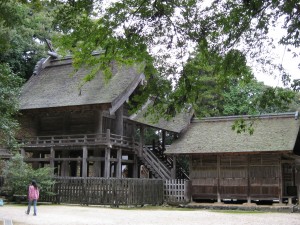In older books about Shinto, you often read that the word ‘kami’ derives from the word for ‘upper’ or ‘superior’. It makes good sense if you think of a deity as a superior being. It makes even better sense in a Japanese context, for the kami is always physically higher than humans. Kamidana (spirit shelves) are placed above eye level within the house, and at shrines the place where the kami resides is raised above the place of worship.

In Shinto shrines kami are housed in a higher position than humans. On the left is the honden containing the kami's spirit body (goshintai), and on the right is the worship hall (haiden).
It turns out, however, that the equation of kami with the meaning of superior or higher is a false etymology according to modern scholarship. In The World of Shinto by Sonoda Minoru*, the head priest of Chichibu Shrine says that the word most likely originates from the ancient Japanese kumu or kuma, meaning a secret place or recess where things are concealed. Over time it evolved into kami, meaning something hidden or invisible.
Sonoda goes on to say that another meaning of kami as the upper part of a river may have also derived from kumu or kuma. The usage may have referred to the hidden source from which the life-giving water originated. For the rice-growing settlements the mysterious power that provided the water on which they depended became known as kami.
Unknown and concealed from view. Life giving and life destroying. Neither singular nor plural, these early kami had no form, no name and no substance. Villagers set up sacred areas in groves to welcome them down from the hills and held special rituals and festivals. Offerings and entertainment became a means of placating the kami and cultivating their good favour. In a land of floods, earthquakes and other disasters, it was a matter of life and death.
***************************************************************
* The World of Shinto, Reflections of a Shinto Priest by Sonoda Minoru is a small booklet published by the International Shinto Foundation in 2009

A.J. Dickinson comments…
The Cave of The Heart
The Self-Secret Spiritual Center
From which all flows